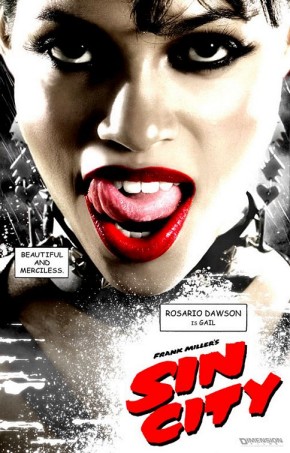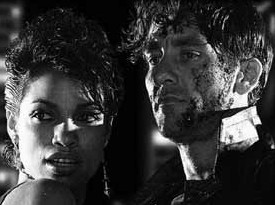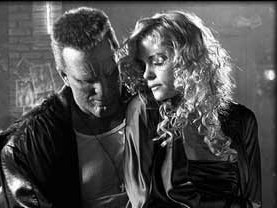|
Sin
City
Robert Rodriguez and Frank Miller unleash a monster of a
film that will satisfy comic loving fanboys of the world
while knocking those unfamiliar with Miller’s noir-esque
“Sin City” for an unexpected loop. Part love
letter. Part experiment. Sin City is all main-lined
adrenal overload. This film is a black and white dreamscape
covered in blood, sweat, and risk.
Risk
is what Rodriguez does best. His top work has always maintained
a certain kinetic energy. It’s only when he’s
comfortable that his work painfully shows weaknesses in
plot. With Sin City, (to crib from Marv) “There
is no settling down! This is blood for blood and by the
gallons. This is the old days, the bad days, the all or
nothing days. They're back!” and at times it feels
as if Rodriguez has been teleported back to the “do
or die” mindset of the medical experiment funded El
Mariachi.
Each
Hi Def frame pulsates in contrasted tones. It’s masterfully
bleak, sullen, and packing the weight of a sledgehammer.
Sin City is unrelenting from start to finish, pulling from
three of Miller’s “Sin City” graphic novels,
crafting a yarn from three very different pulp heroes residing
in Basin City. The framing is uncanny and the dialogue is
verbatim in most places, while tightly extracting all unnecessary
aspects for sake of time, consolidation, and coherence.
Yes
that is correct. The word “coherence” was just
attributed to a Robert Rodriguez film. In fact, the last
thing expected from Sin City was sound structure.
It would
seem that, in Miller, Rodriguez has found the missing variable
in his guerilla filmmaking formula. To call him a “style
over substance” guy is an understatement as his ability
to string together action sequence after action sequence
has often carried him from project to project. The trouble
is, chain linked action does not an intriguing film make.
With
Sin City, Miller provides the depth behind the
panache, and what results is a film that lives and breathes
all on its own. Sure, Miller’s text is a one-note
tune to the beat of noir infused nihilism, but what results
is of more substance and life than any of Rodriguez’s
previous efforts combined.
Miller
isn’t simply paying homage to one specific style or
genre here, he is fusing together the “comic book”
and the “pulp novel.” Amalgamation such as this
can easily fail because it is nearly impossible to please
fans of both genres at once. Those familiar with classic noir
such as Out of the Past, Asphalt Jungle, and Farewell,
My Lovely would ever expect comic super heroism rolled
up with noir aesthetic.
The
“Sin City” graphic novels steep in this very
concept, serving as blueprints for the film, and actually
more as storyboards than mere adaptive material. Atypical
comics were not commonly filled with the grit of noir and
pulp; that is, until Miller begin infusing characters like
Daredevil and Batman with qualities mirroring protagonists
like those created by Raymond Chandler, Dashiell Hammett,
Jim Thompson, and James Cain.
Bottom
line, this is one of the goriest high charge films in some
time, and the film borrows to new depths with each brutal
turn. Uninitiated audiences will not feel left behind, as
they were likely primed for Sin City with Quentin
Tarantino’s Kill Bill. Tarantino holds a “guest
director” credit here, although which sequence was
his is neither important nor distinguishable.
The
playful grim coated banter of noir pulp dramas can either
flow or flop in the wind, but this cast manages to pull
it out. The most standout of the lot is Mickey Rourke who,
donning facial prosthetics enhancing both chin and brow,
plays the streetwise toughie named Marv with an enthralling
buzz of energy that sadistically takes hold of the audience
and never relents, all the way up to the bitter end.
Rourke’s
delivery meshes seamlessly with Rodriguez’s precision
pacing which always remains in tandem with Miller’s
text. It’s easy to see that Sin City succeeds
solely due to the dedication of all those involved. Re-read
the sequence between Marv and the Priest (played by Miller
himself) after screening the film and you’ll realize
that this sequence exists on-screen just as it does on the
page.
Jessica
Alba is perfect as Nancy Callahan, a stripper with a stained
past and a love that is both wrong and endearing at once.
Alba brings life to what could have felt like a simple,
two-dimensional Nancy. Many will claim that Benicio Del
Toro was wasted as Jack Rafferty. Truth is, watching Benicio
lose himself in this character, as loathsome as he is, is
haunting. Willis carries himself well as Hartigan, a due
to retire cop with angina-like symptoms.
Nick
Stahl fits, as the slippery and greasy Junior Roark, a villain
whose possible existence is enough to make one shudder.
One case of doubtful casting was Elijah Wood’s turn
as a feral cannibal killer named Kevin. Wood’s performance
is spot on, blending together futile despair with downright
creepy sentiment. Their fates are as gruesome as they come,
and even more deserved. These two villains mirror the more
political corruption and greed of Basin City with visceral
depravity of morals and mores of “civilized”
culture.
Miller’s
Basin City houses not only corrupted politicians whose wealth
provides the power to write laws, but also the socially
disturbed who physically prey on innocence. It’s not
enough that these two extremes of evil exist independently.
No, the true horror lies in the ties between the two, the
suggestion that one perpetuates the other, and the implication
that, more often than not, these two forces get the upper
hand on the rest of us.
Rating:

|








